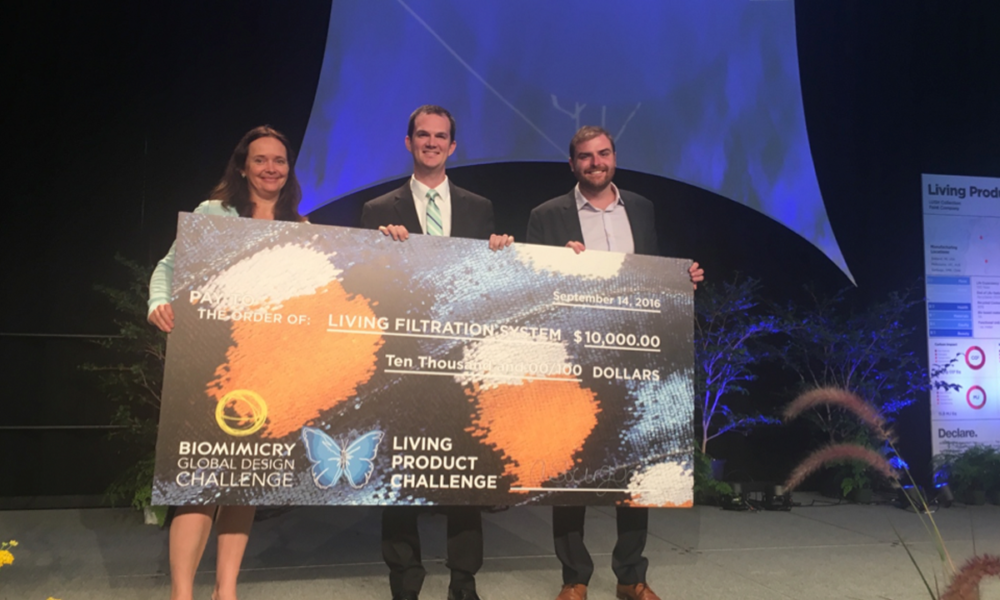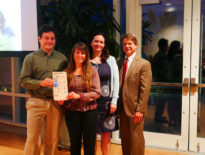A University of Oregon design team has won the first Living Product Prize in the Biomimicry Global Design Challenge for the Living Filtration System, an innovation that creates healthier soils by preventing nutrients from leaving fields in runoff. Their $10,000 Living Product Prize win was announced at the Living Product Expo in Pittsburgh, PA yesterday.
“Living Filtration System has proven the adage that if it exists, it must be possible,” said International Living Future Institute CEO Amanda Sturgeon, in presenting the award. “With an elegant design and a sustainable intention, the Living Filtration System was inspired by biomimicry, mimicking the form and function of earthworms in creating natural filtration systems. This innovative product has the real potential to transform agriculture.”

The Living Product Prize is a new initiative of the Biomimicry Global Design Challenge, an annual team competition hosted by the Biomimicry Institute and the Ray C. Anderson Foundation that focuses on nature-inspired solutions to critical sustainability issues. Entries for the Living Product Prize must meet the rigorous performance categories outlined in the Living Product Challenge (LPC), a program of the International Living Future Institute. The goal of the prize is to highlight design products that mimic nature’s design principles and function as elegantly as anything found in the natural world. There are two awards – a $1,500 prize for a student team, and a $10,000 prize for a team in the Biomimicry Global Design Challenge Accelerator. The student prize was awarded in August 2016 to AquaCity Garden, a modular garden system designed for interior spaces that uses less water, is more space efficient, and promotes healthy eating.
The Living Filtration System is a biomimetic-inspired concept designed to mitigate the environmental impact of agriculture, inspired by the form and function of earthworms, wetlands and the human small intestine. This transitional technology was created to replace conventional agricultural drainage systems and capture excess nutrients in runoff, reducing fertilizer use and improving soil health.
“The Living Product Challenge criteria provide excellent guidance for how teams can apply nature’s deep principles to the design of their products,” says Megan Schuknecht, the Biomimicry Institute’s director of design challenges. “The criteria emphasize outcomes that help our design challenge teams situate their designs and business plans within a regenerative, systems context. Together with the International Living Future Institute, we are working to transform products and systems to be in harmony with nature.”
About the Living Product Challenge
The Living Product Challenge, a program of the International Living Future Institute re-imagines the design and construction of products to function as elegantly and efficiently as anything found in the natural world. Living Products are informed by biomimicry and biophilia; manufactured by processes powered only by renewable energy and within the water balance of the places they are made. Living Products improve our quality of life and bring joy through their beauty and functionality. Imagine a Living Product whose very existence builds soil; creates habitat; nourishes the human spirit; and provides inspiration for personal, political and economic change.
About the Biomimicry Global Design Challenge
The Biomimicry Global Design Challenge is the Biomimicry Institute’s flagship challenge, hosted in partnership with the Ray C. Anderson Foundation. It is an annual competition that invites students and professionals to address critical sustainability issues with nature-inspired solutions. Finalists and winners selected by our expert jury are eligible to win prize money as well as assistance in bringing their solution to the global marketplace via an Accelerator program. At the end of the Accelerator, one team will be awarded the $100,000 “Ray of Hope” prize, endowed by the Ray C. Anderson Foundation. The first Ray of Hope prize will be awarded in October 2016 at Bioneers.
The Challenge is coordinated each year around a theme, or problem area, for which participating teams are asked to design solutions. Learn more about the current theme by reading the Challenge brief and browsing the reference collection. To help teams that are new to the practice of biomimicry, the Biomimicry Institute also provides extensive online resources as well as a directory of experts and mentors who are available as advisors.
The Challenge includes two entry categories: one for students only (high school or university) and an open category, which teams of any composition can enter. Judging and awards are category specific and only entrants in the open category are eligible to advance to the Accelerator program.
About the Ray C. Anderson Foundation
The Ray C. Anderson Foundation is a 501(c)(3) not-for-profit organization that seeks to promote a sustainable society by supporting and funding educational and project-based initiatives that advance knowledge and innovation in sustainability. http://www.raycandersonfoundation.org


